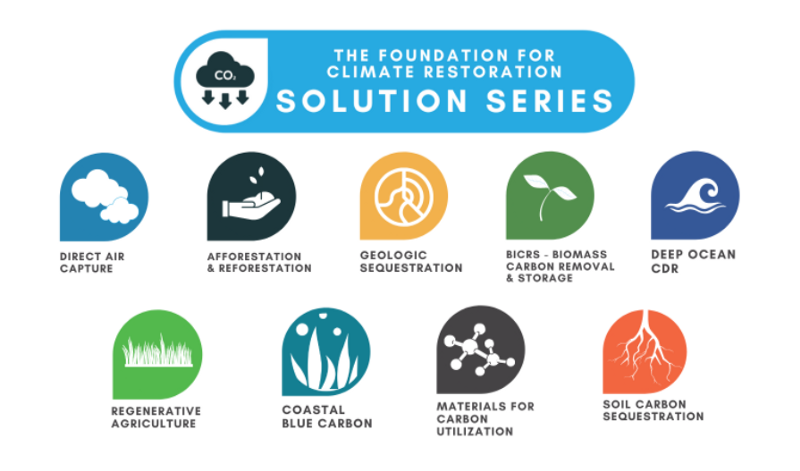Solution Series: Direct Air Capture

At F4CR, we’re often asked, “What are the solutions that can restore the climate?” This is a surprisingly hard question to answer, given that:
- The field of carbon dioxide removal (CDR) is very new and most solutions haven’t yet been studied in detail,
- Each solution has unique benefits and drawbacks, and
- There are few resources that compare different CDR approaches to one another in an easily digestible way.
Over the next nine months, we will attempt to answer this question (and more!) as they relate to nine categories of CDR solutions. In month 1 of our new Solution Series, we examine the potential of Direct Air Capture (DAC) to contribute to climate restoration. Our recently released DAC White Paper looks in greater detail at DAC’s climate restoration potential in terms of durability, financeability, scalability, and equity. This blog post gives a brief overview of some key points.
What is direct air capture?
Direct air capture refers to technologies that use a chemical approach to capture CO2 from ambient air. It’s different from carbon capture and storage (CCS), which captures emissions at a point-source like a smokestack. We are focusing on DAC because it has the capacity to address the legacy emissions already present in our atmosphere, rather than being limited to offsetting current emissions.
Can DAC restore the climate?
DAC holds potential as a climate restoration solution as it can be durable, financeable, scalable, and equitable, if developed and deployed thoughtfully.
Durability: Typically, technological CDR solutions like DAC only address one side of the carbon removal + carbon storage/use equation. DAC refers to a method of removing CO2 from the air, but that captured CO2 can then be used in any number of ways. Ultimately it is the use of the CO2 that determines its durability, so DAC does not inherently have a durability score. Some uses of CO2 are highly durable (e.g., pumping it into underground rock formations where it binds with the rock), and others are not (e.g., using the CO2 to carbonate sodas).
Financeability: A learning-by-doing approach, similar to what was applied to driving down the cost of solar energy, can be used to further decrease the cost of DAC while being supported by early policy and initiatives. In recent years, DAC plants have increased in number and scale, and investments in DAC from governments and companies have risen in turn. There is also an opportunity for polluters to take on a substantial share of the cost of DAC as a means of cleaning up the mess of excess CO2 for which they’re responsible.
Scalability: One of the key constraints in scaling DAC is its high energy needs. Locating facilities next to excess energy from waste heat streams, wind, and solar can help curtail DAC’s energy footprint. Simultaneously, R&D is ramping up to reduce DAC’s energy needs through innovation.
Equity: DAC can be implemented equitably, but doing so requires careful consideration of risks and participation of potentially impacted communities. To be equitable, DAC project developers need to work hand-in-hand with local and at-risk communities to ensure they are aware of the potential benefits, burdens, and tradeoffs while deciding on environmental justice safeguards to protect against any unforeseen circumstances. Additionally, allowing the community to have the final decision in project implementation is essential to adhere to the equity principle. DAC’s equitable deployment can be advanced by prioritizing projects that can bring benefit to these communities through job creation, reducing air pollutants, or allocating a portion of the profits to support the community.
In mobilizing the deployment of DAC, it is our responsibility as advocates to work together with a diverse group of stakeholders, acknowledging the concerns and risks that are possible while amplifying the non-climate benefits DAC can provide. We can support the scaling up of DAC by educating ourselves and others while advocating for the increased R&D, financial investment, and policies needed for safe and equitable deployment.
Interested in learning more about DAC? Download our DAC White Paper and register for our DAC expert panel on April 26 at 1:00 pm Pacific.